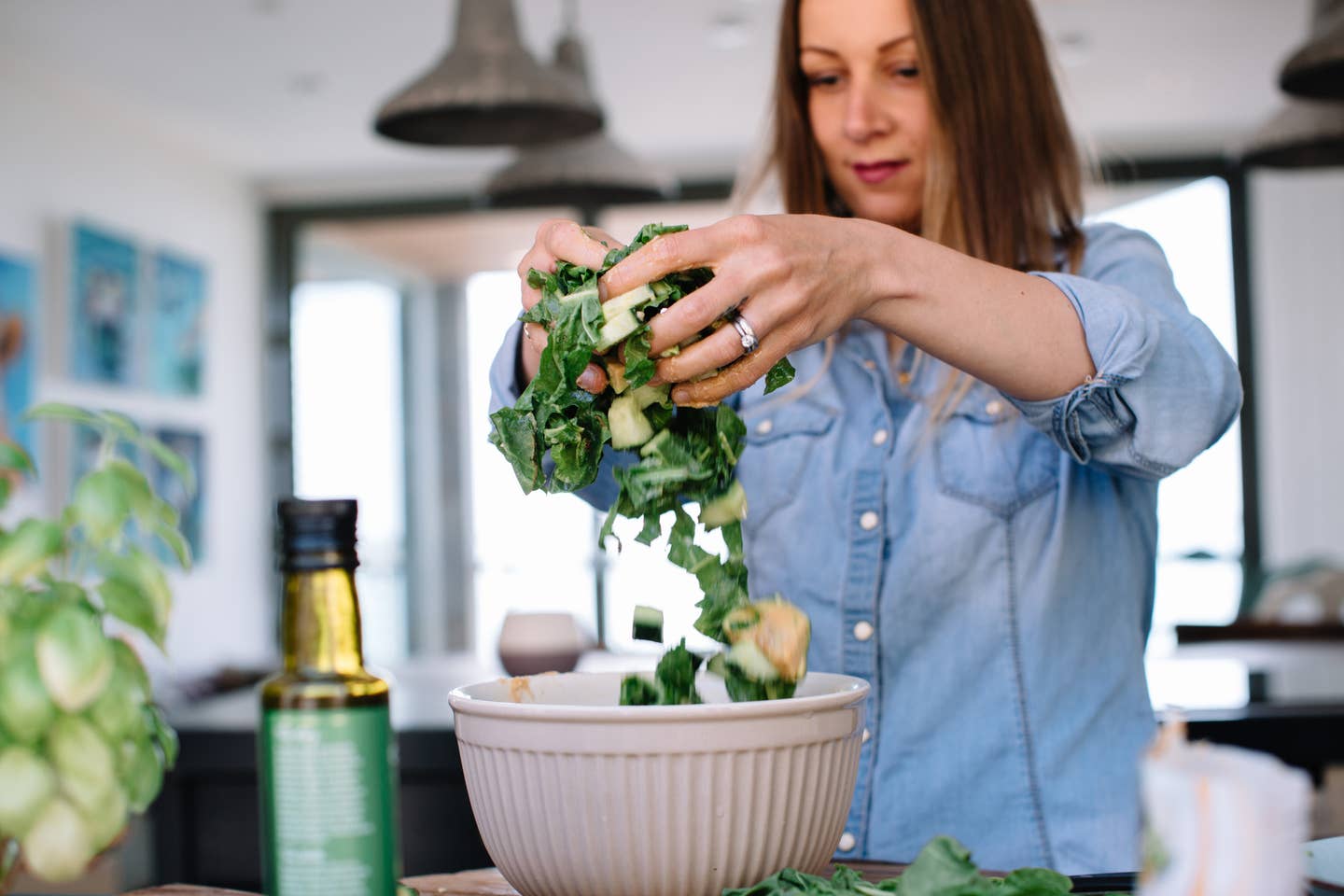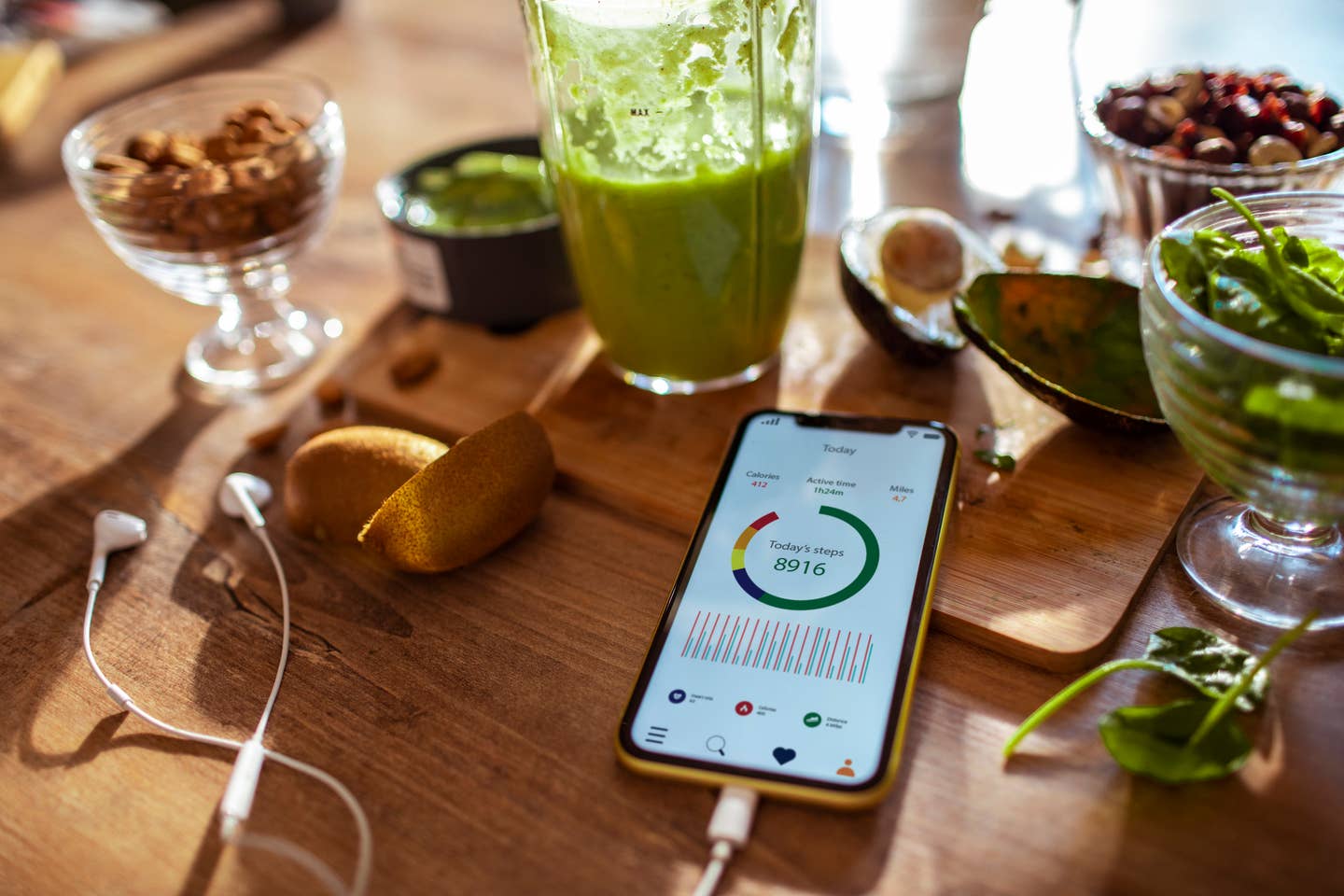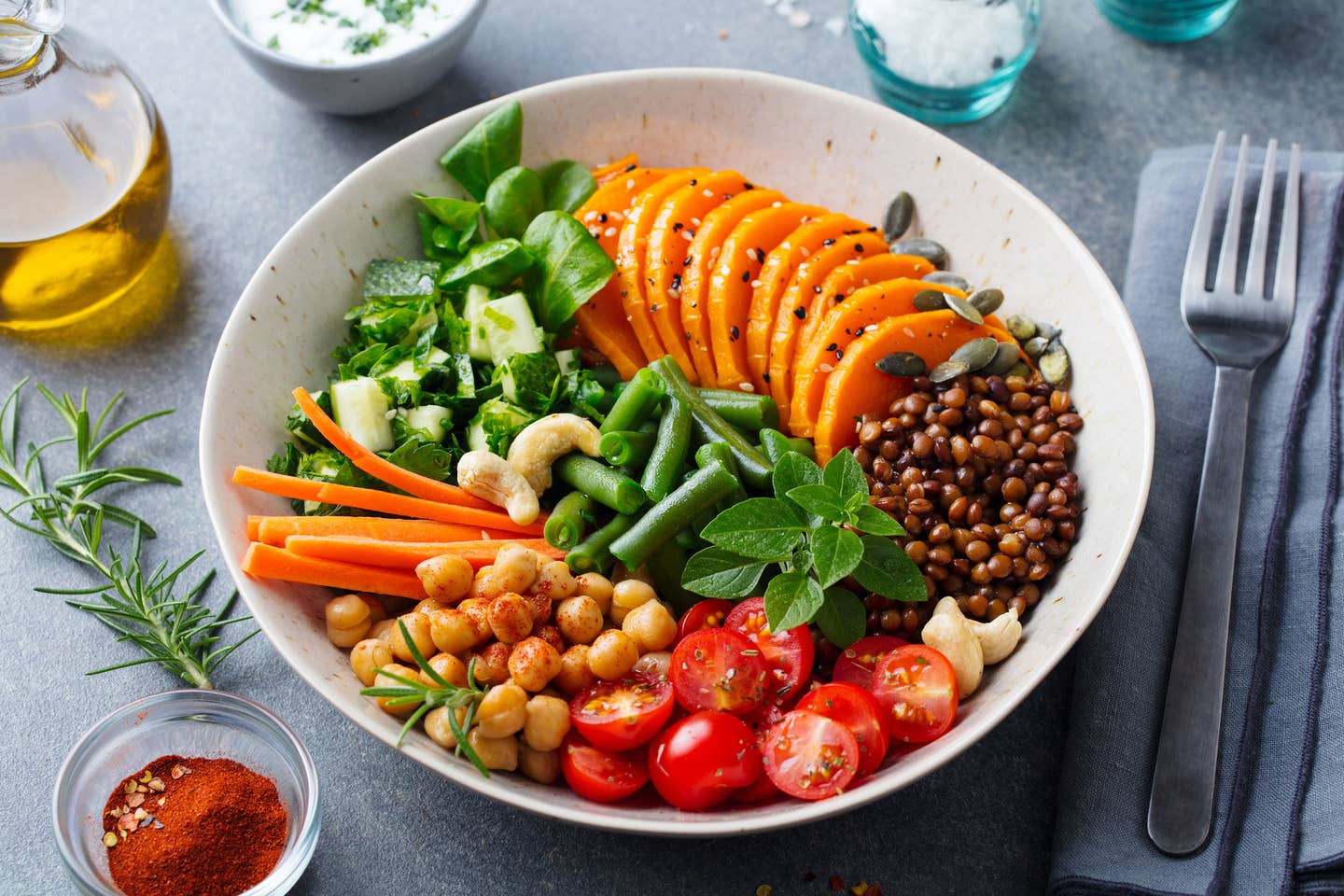
The Truth About Metabolism: It Doesn’t Actually Change As We Age
In a new study that looked at how metabolism fluctuates over the course of our lifetime, a revealing measure found that our metabolism remains largely constant between the age of 20 and 60. So if you're looking to get lean, stay fit, or even lose weight, don't blame your aging metabolism. Instead, take a look at your diet and exercise habits, and other lifestyle factors.
The study measured a key indicator of the amount of energy we burn both at rest or doing daily tasks like eating, and during our daily workouts, which is the amount of CO2 we exhale. This method reliably measures the number of calories we burn, since, by breathing, we exhale the carbon dioxide that gets broken down when cells use energy for fuel.
The study, published this month in Science, used data from 6,421 males and females ranging in age from eight days old to 95 years of age and found that people's metabolisms don't slow down with age, as we previously thought. Adjusted for weight, size, and activity, women and men have equal chances of keeping their metabolism healthy as they age, the study also found.
A lifetime of change in your metabolism
The researcher's measurements looked at "total and basal energy" output over the years and found that the most dramatic slowing of metabolism happens between the ages of one and 20, as we grow into our adulthood height and weight, and then we hit cruise control, metabolism-wise, until 60. After that, it slows down again, but at a much smaller rate.
During the first year of life, the growing baby's metabolism speeds up quickly as it grows fast until the baby reaches the age of 1, and then starts to slow year by year until the age of 20. So the takeaway seems to be that if we continue to eat healthily, a mostly plant-based diet high in vegetables, fruit, whole grains, nuts, seeds, and legumes, and we exercise and do strength training to keep up our muscle tone, we can enjoy a robust metabolism throughout most of our lives.
Here's how your metabolism changes over time
- For the first year of life from 0 to 1-year-old, your metabolic rate rises to 50 percent higher than when you're an adult
- From the age of 1 to 20 years old, your metabolism drops by nearly 3 percent a year.
- From age of 20 to 60, your metabolism doesn't change
- After 60, your metabolism drops slightly every year, by 0.7 percent
“These data suggest that the `middle-age spread’ that we all know about anecdotally or personally is not due to a change in intrinsic metabolism as had been long thought,” says Rozalyn Anderson, Ph.D., co-author of an article published alongside the study. She is a professor on the Geriatrics Faculty, Veterans Administration Hospital in Overlook Terrace, at the University of Wisconsin. “It is far more likely now that changes in behavior are at the root of it.” Essentially, this means that our diet and exercise, stress levels, and lifestyle behaviors (how much we sleep, drink, and our ability to cope with adversity) all play a role in how well we age.
Why your metabolism matters
Metabolism is the rate at which your body burns calories for fuel and as your energy needs chance so do your caloric burning rates. But if you think: As I get older I will inevitably slow down, that becomes a self-fulfilling prophecy, since your body doesn't need to "slow down." In fact, studies show you actually need to add more strength training to your daily regimen to keep up your muscle tone as you age.
The body naturally loses about 1 percent of its muscle tone every year after the age of 30, studies have shown. This is called sarcopenia and the reason it impacts metabolism is that muscle burns more calories at rest than fat does, so the more you keep your lean muscle tone the more likely you will be able to stay fit, healthy and maintain your healthy weight as you age.
Building strong muscle and maintaining a healthy diet are the keys to keeping your metabolism going at the same rate at 40 or 50 or even 60 as you enjoyed at 20, this new study indicates. "Aging is not a disease. There are diseases of aging, but it doesn't mean they are inevitable," Susan Vannucci, RD, Ph.D. a wellness expert in New York City, who provides individual wellness counseling for individuals age 45 and up, told The Beet. She advises her clients to strength train at least three times a week and to eat a healthy diet.
Vannucci advises anyone in their 30s, 40s, and beyond to stay away from all processed food, especially junk food, and instead concentrate on an anti-inflammation diet, consisting mostly of plant-based foods. But eat them in their whole form since potato chips are plant-based but not healthy.
Bottom Line: Your metabolism doesn't change much from 20 to 60. If you want to keep your metabolism high and keep your body burning at a higher rate of calories, then keep strength training and eating a healthy, plant-based diet.
The Top 20 Veggies with the Most Protein
Everyone who contemplates going plant-based has the same question: where do I get my protein? Simple answer: Vegetables! Contrary to the popular belief that you have to eat animal protein to get enough into your diet, one of the best ways to get protein is by eating vegetables. Animals provide protein because they're fed a diet of plants that are high in protein, so if you cut out the middleman -- or middle cow or middle chicken in this case -- you can get the same protein just by going direct-to-the-source.
1. Soy Beans
Soybeans are a legume but they are such a great source of protein that we had to lead the veggie list with it. There is more protein in just one ounce of soybeans than a cup of sliced avocado!1 cup equalsProtein - 28.6gCalories - 298Carbs - 17.1gFiber - 10.3gCalcium - 175mg
2. Peas
If the pod, that peas are grown in, is split down the middle, that is an indicator they are ripe. Seeds inside the pod vary and can be green, white or yellow. 1 cup equalsProtein - 8.6gCalories - 134Carbs - 25gFiber - 8.8gCalcium - 43.2 mg
3. Corn
Fresh corn is a great source of energy for those who like to stay active. Protein isn't all that corn has to offer. Corn provides the body with potassium and B vitamins. 1 cup equalsProtein - 5.4gCalories - 177Carbs - 123gFiber - 4.6gCalcium - 4.9mg
4. Artichoke Hearts
Artichokes are part of the sunflower family. The fiber in artichoke hearts is great for supporting digestion. 1 cup equals Protein - 4.8g Calories - 89 Carbs - 20g Fiber - 14.4g Calcium - 35.2mg
5. Asparagus
If not properly stored, Asparagus tends to go bad quickly, To elongate freshness, put damp paper towels around the stems, or place the entire asparagus bunch in a cup of water (like flowers) to maintain freshness longer. 1 cup equals Protein - 4.4g Calories - 39.6 Carbs - 7.4g Fiber - 3.6g Calcium - 41.4mg
6. Brussel Sprouts
Brussel sprouts have more Vitamin C than an orange. If your Brussel sprouts have a rancid odor that is an indicator you overcooked them. The smell occurs because the sprouts are composed of a great amount of sulforaphane. 1 cup equals Protein - 4g Calories - 56.2 Carbs - 40g Fiber - 4g Calcium - 56.2mg
7. Broccoli
If you are trying to lose weight broccoli is a great addition to your diet because it consists of 90 water and is also high in fiber. 1 cup (chopped) equals Protein - 3.8g Calories - 54.6Carbs - 11.2g Fiber - 5.2g Calcium - 62.4mg
8. Mustard Greens
Mustard greens provide the body with tons of Vitamin A, Vitamin C, Vitamin K and fiber. Adding steamed mustard greens into your diet has been known to lower cholesterol and reduce inflammation. 1 cup equals Protein - 3.2 g Calories - 21 Carbs - 2.9g Fiber - 2.8g Calcium - 104mg
9. Avocado
Avocado is commonly mistaken as a vegetable but it is technically a fruit. This fruit had to be included in our veggie list because it isn't just tasty but super nutritious. Avocados are packed with protein but they are a great source of potassium and fiber. Avocados are a great addition to any salad, sandwich and even smoothie! 1 cup equals Protein - 3.0 g Calories - 240 Carbs - 12.8 g Fiber - 10.1g Calcium - 18 mg
10. Onions
Onions are an unappreciated food hero since they provide 20 percent of your daily Vitamin C and deliver an abundance of antioxidants that can reduce inflammation.1 cup (chopped) equalsProtein - 2.9gCalories - 92.4Carbs - 21.3gFiber - 2.9gCalcium - 46.2mg
11. Beets
The entire beetroot is edible including the leaves which contain loads of vitamin A, calcium, iron and potassium. Beetroot is high in sugar but is considered one of the most nutritious veggies used in salads and soups. 1 cup equals Protein - 2.8 g Calories - 74.8 Carbs - 17g Fiber - 3.4g Calcium - 27.2mg
12. Oyster Mushrooms
Oyster mushrooms are commonly seen in Chinese dishes. They grow best in a controlled environment indoors. Oyster mushrooms have so many nutrients to offer besides protein such as iron, calcium, zinc and folic acid. 1 cup (raw and sliced) equals Protein - 2.8g Calories - 37 Carbs - 5.6g Fiber - 2.0g Calcium - 2.6mg
13. Bok Choy
Bok Choy is a member of the mustard family. One of the oldest cultivated vegetables in the world, Bok Choy means "white vegetable” and is a great source of vitamins A, C, B6, K, and E, magnesium, potassium, iron, manganese, and calcium. 1 cup equals Protein - 2.7 g Calories - 20.4 Carbs - 3.1g Fiber - 1.7g Calcium - 158mg
14. Green Beans
Green beans are a great source of vitamins B, C and K, and minerals such as magnesium, iron and manganese. Green beans should be cooked before eating, to destroy lectins. China is the biggest grower of green beans in the world, exporting over 15 million tons a year. 1 cup equals Protein - 1.8 g Calories - 31 Carbs - 7 g Fiber - 2.7 g Calcium - 37 mg
15. Cauliflower
The most nutritious way to consume cauliflower is steamed. Don't get intimidated by orange, purple or green cauliflower. All three types have the same benefits as white cauliflower. 1 cup equals Protein - 2.2g Calories - 28.6 Carbs - 5.4g Fiber - 2.8g Calcium - 19.8mg
16. Turnip
You can eat the entire plant, root and leaves. The turnip root is high in vitamin C and the greens are high in vitamins A, C, E, B6 and K, believed to counter inflammation. Add turnip roots to soup, or mash them. Add them to salads. 1 cup equals Protein - 1.6g Calories - 28.8 Carbs - 6.3g Fiber - 5.0g Calcium - 197mg
17. Alfalfa Sprouts
Alfalfa sprouts might be little but they sure are powerful. Plus they're quick and easy to grow. They are loaded with Vitamin C, Vitamin K, Iron and more. But because they have been known to carry bacteria, make sure to fully cook alfalfa sprouts if you have a fragile immune system or are pregnant. 1 cup equals Protein - 1.3 g Calories - 8 Carbs - 0.7 g Fiber - 0.6 g Calcium - 10.6 mg
18. Tomatoes
Keep your tomatoes fresher for longer by storing them stem down. When exposed to sunlight the Vitamin C in a tomato will diminish. 1 cup equals Protein - 1.3g Calories - 26.8 Carbs - 5.8g Fiber - 1.8g Calcium - 14.9mg
19. Zucchini
Zucchini has an abundance of potassium, even more than a banana! The reason zucchini isn't high in calories is that it is made up of 95% water. 1 cup equals Protein - 1.2g Calories - 28.8 Carbs - 7.1g Fiber - 2.5g Calcium - 23.4 mg
20. Spinach
Spinach is filled with Vitamin A, Vitamin E, Vitamin K, fiber and protein. The best part about spinach is you can sauté it, blend it or eat it raw! Spinach is best grown in rainy and cool weather. 1 cup equalsProtein - 0.9gCalories - 6.4Carbs - 1.0 gFiber - 0.6gCalcium - 27.7 mg
More From The Beet






